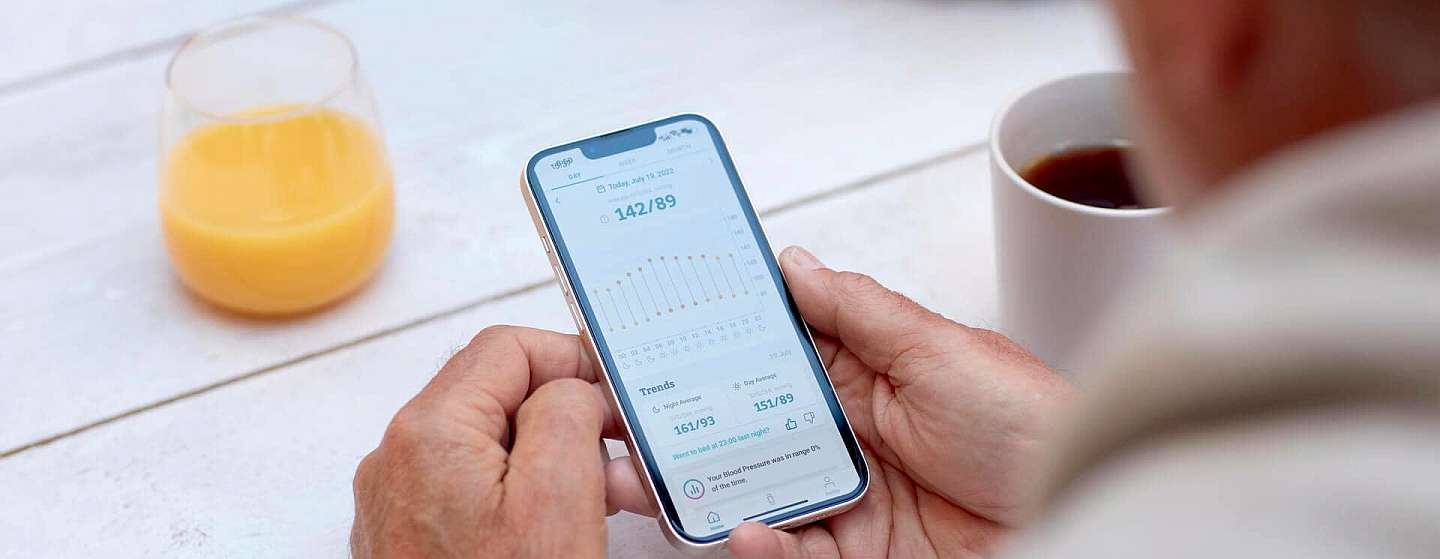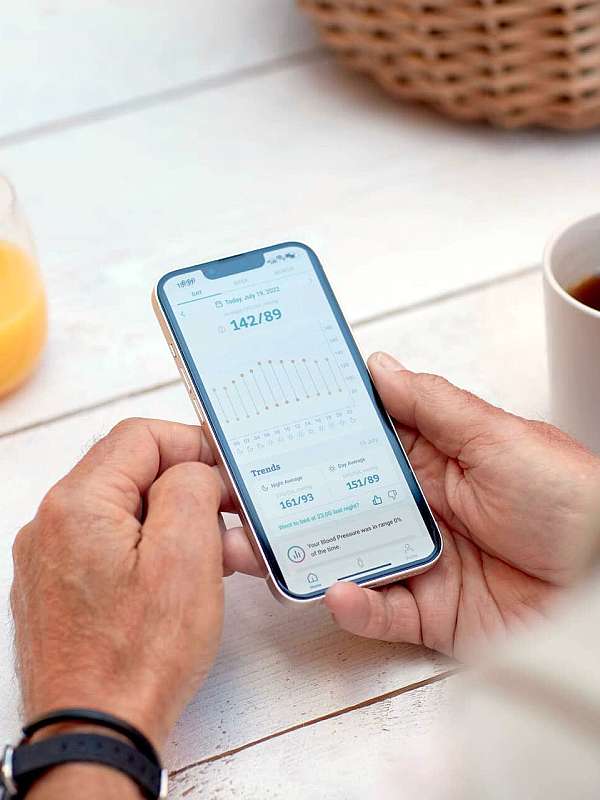We all know that a healthy lifestyle includes regular exercise, getting plenty of sleep and eating a balanced diet. Commonly accepted markers of good health include energy levels, body mass index (BMI), cholesterol levels and blood pressure. Of these, it’s easy enough to track energy levels and BMI, but monitoring blood pressure and cholesterol is considered more difficult. Well, that has all changed and the Hilo Band 24/7 blood pressure monitor allows you to keep an eye on your blood pressure daily, from your own home, giving valuable insight into your health statistics and potentially alerting you to any underlying health issues. In addition, tracking blood pressure daily can give you a more realistic longitudinal reading because patients can have raised blood pressure in a medical setting (referred to as white coat hypertension), which can mask true hypertension or provide inaccurate data.
Why regular blood pressure readings are important
Blood pressure is the force required for your heart to pump blood around your body. The higher your blood pressure, the more at-risk you are of developing serious long-term conditions such as coronary heart disease and stroke.
Regularly monitoring your blood pressure is especially important for people diagnosed with hypertension (high blood pressure). Keeping track of your numbers helps your GP understand if your treatment is working, and it helps you see how lifestyle changes support your heart health.
For example, say your healthcare provider advised you to move more throughout the day, so you committed to going on a daily walk. When you consistently monitor your blood pressure, you’ll be able to see how regular activity affects your readings, which can give you the motivation you need to turn a positive change into a lifelong habit.
‘Consistently’ is an important term here, as there are a lot of factors that can impact your readings ranging from your stress levels to whether you’ve had caffeine. The occasional reading you receive at a clinic gives your healthcare team a snapshot of your overall health, but for the most accurate results, you’ll want to collect daily readings over several weeks.
What do blood pressure readings mean?
When you measure your blood pressure, you get two numbers: the systolic and diastolic pressures.
- Systolic blood pressure is the first, or top, number. It indicates how much pressure your blood exerts against your artery walls when your heart beats.
- Diastolic blood pressure is the second, or bottom, number. This is the lowest level your pressure reaches when your heart relaxes.
Systolic blood pressure is measured first, followed by diastolic, with the unit mm HG (millimeters of mercury). If your systolic blood pressure is 90 and your diastolic is 60, you’d read it as 90/60 or 90 over 60.
Here’s a general guide to what the numbers mean according to the Heart Foundation of Australia:
| Blood Pressure | What it means |
| <120/80 | Optimal |
| 120-129/80-84 | Normal |
| 130-139/85-89 | High-normal |
| >140/>90 | High |
It’s worth noting that blood pressure can vary widely among people based on their age and biological sex. For example, the average normal blood pressure for men aged 60+ is 133/69 whereas for women in that same age group, the average is 139/68. There are also ranges of normal blood pressure from different medical associations. For example, the American College of Cardiology defines the blood pressure target for people aged 65+ as less than 130/80, whereas the European Society of Hypertension suggests 140/90, although 130/80 is preferable.
What does all that variability mean for you? Although blood pressure can fall into healthy ranges, there isn’t a single magic number that works for everyone. Working with your healthcare provider is the best way to identify a healthy blood pressure for you.
How to take blood pressure readings at home
There are different types of blood pressure monitors for home use:
| Monitor type | How it works |
| Inflatable cuff | These devices are easily found at most pharmacies. They work by inflating to squeeze the arm, then calculating your blood pressure based on your blood flow while the cuff deflates. |
| Finger monitor | These devices measure arterial pressure in your finger. Although there are a range of options on the market, they’re generally considered to be unreliable. |
| Wrist monitor | Hilo Band is a 24/7 monitor that you wear on your wrist. It uses special photoplethysmographic (PPG) sensors to estimate your blood pressure whenever you’re still, day or night. |
Most people are familiar with cuff-based devices, but these monitors require some extra planning to use them accurately:
- Sit properly during the reading: still, back straight, legs and arms uncrossed.
- Avoid taking your readings after drinking caffeinated beverages, exercising or smoking.
- Measure blood pressure using a cuff around your upper arm, but make sure that the cuff size is correct.
For maximum accuracy, you’ll need to measure around the same time daily, for example first thing in the morning or last thing at night. In addition, when taking blood pressure with a cuff for the first time, take multiple readings daily, say for a week, and then average them. This will give you a baseline value. After this time, one reading at the same time each day will suffice. Write down the results to share them with your GP.
That’s a lot of planning. Hilo Band is different; as a lightweight bracelet you can wear 24/7, the Hilo Band makes it easy to take multiple readings at different times of the day. That’s because Hilo automatically detects the optimal time to measure your blood pressure and logs your results throughout the day and night. (No special posture or manually logging your numbers required!)
You can review everything in the app, and even share your data with your GP so you can discuss your readings together. This information sets you up for success by revealing whether you experience a drop in blood pressure while you sleep, as well the impact of medication or stress.
Stay up to date with the latest in blood pressure monitoring tech and take charge of your health. Join our newsletter today!
How to address high blood pressure
One high blood pressure reading isn’t necessarily cause for alarm; it may be a sign that you’re stressed, slept poorly, or had too much caffeine before your reading. However, consistently high blood pressure readings are a sign that it’s time to take action. With the Hilo Band and its in-app ‘time in range’ graph, you will be able to visualise your blood pressure patterns and check for consistency, be it good or bad.
If you do have hypertension your GP may prescribe medication, and there are many different types of medication. Some work by relaxing your blood vessels, while others make your heart beat more slowly and with less force. Your GP will help you determine which medication is right for you.
You can also support your heart health with lifestyle changes, such as exercising regularly, cutting back on salt and refined sugars, and quitting smoking. Check out these tips to reduce blood pressure for more details.
Summary
Regular blood pressure readings are essential for maintaining good health, especially if you have borderline high blood pressure (prehypertension) or have been diagnosed with hypertension. While cuff-based devices are easy to find, they’re not necessarily easy to use. With Hilo Band, you’ll have an easy-to-use way to monitor your blood pressure throughout the day without having to lift a finger. That way, you can focus on what really matters: living your life and taking control of your health.
Disclaimer: The information in this article is intended for educational purposes only and does not replace medical advice. If you suspect hypertension or are worried about your blood pressure, speak with your GP or qualified healthcare professional.
Sources
High blood pressure and how to lower it. Healthdirect Australia. https://www.healthdirect.gov.au/high-blood-pressure-and-how-to-lower-it (Accessed October 2025)
Blood pressure and your heart. Heart Foundation. https://www.heartfoundation.org.au/your-heart/blood-pressure-and-your-heart (Accessed October 2025)
How to measure home blood pressure: Recommendations for healthcare professionals and patients. Royal Australian College of General Practitioners. https://www.racgp.org.au/afp/2016/january-february/how-to-measure-home-blood-pressure-recommendations (Accessed October 2025)
High blood pressure. Australian Institute of Health and Welfare. https://www.aihw.gov.au/reports/risk-factors/high-blood-pressure/contents/summary (Accessed October 2025)
Blood pressure monitoring at home. Healthdirect Australia. https://www.healthdirect.gov.au/blood-pressure-monitoring-at-home (Accessed October 2025)
Hilo Band: Easy 24/7 blood pressure monitoring. Hilo Australia. https://hilo.com/au/blood-pressure-monitor (Accessed October 2025)
2023 ESH Hypertension Guideline Update: Bringing Us Closer Together Across the Pond. American College of Cardiology. https://www.acc.org/Latest-in-Cardiology/Articles/2024/02/05/11/43/2023-ESH-Hypertension-Guideline-Update (Accessed October 2025)






